


目录
🌊1. 研究目的
🌊2. 研究准备
🌊3. 研究内容
🌍3.1 多层感知机模型选择、⽋拟合和过拟合
🌍3.2 基础练习
🌊4. 研究体会
🌊1. 研究目的
-
多层感知机模型选择:比较不同多层感知机模型的性能,选择最适合解决给定问题的模型;
-
欠拟合和过拟合:研究模型在训练数据上出现欠拟合或过拟合的情况,以便了解模型的泛化能力和优化方法的效果;
-
模型正则化和调参:通过实验观察和比较,研究正则化技术和调参对模型的影响,以改善模型的泛化性能;
-
模型复杂度与性能:探究多层感知机模型的复杂度对训练和测试性能的影响,以及如何找到合适的模型复杂度。
🌊2. 研究准备
-
根据GPU安装pytorch版本实现GPU运行研究代码;
-
配置环境用来运行 Python、Jupyter Notebook和相关库等相关库。
🌊3. 研究内容
启动jupyter notebook,使用新增的pytorch环境新建ipynb文件,为了检查环境配置是否合理,输入import torch以及torch.cuda.is_available() ,若返回TRUE则说明研究环境配置正确,若返回False但可以正确导入torch则说明pytorch配置成功,但研究运行是在CPU进行的,结果如下:

🌍3.1 多层感知机模型选择、⽋拟合和过拟合
(1)使用jupyter notebook新增的pytorch环境新建ipynb文件,完成基本数据操作的研究代码与练习结果如下:
导入相关库:
import math
import numpy as np
import torch
from torch import nn
from d2l import torch as d2l
生成数据集
max_degree = 20 # 多项式的最大阶数
n_train, n_test = 100, 100 # 训练和测试数据集大小
true_w = np.zeros(max_degree) # 分配大量的空间
true_w[0:4] = np.array([5, 1.2, -3.4, 5.6])features = np.random.normal(size=(n_train + n_test, 1))
np.random.shuffle(features)
poly_features = np.power(features, np.arange(max_degree).reshape(1, -1))
for i in range(max_degree):poly_features[:, i] /= math.gamma(i + 1) # gamma(n)=(n-1)!
# labels的维度:(n_train+n_test,)
labels = np.dot(poly_features, true_w)
labels += np.random.normal(scale=0.1, size=labels.shape)# NumPy ndarray转换为tensor
true_w, features, poly_features, labels = [torch.tensor(x, dtype=torch.float32) for x in [true_w, features, poly_features, labels]]features[:2], poly_features[:2, :], labels[:2]
对模型进行训练和测试
def evaluate_loss(net, data_iter, loss): #@save"""评估给定数据集上模型的损失"""metric = d2l.Accumulator(2) # 损失的总和,样本数量for X, y in data_iter:out = net(X)y = y.reshape(out.shape)l = loss(out, y)metric.add(l.sum(), l.numel())return metric[0] / metric[1]def train(train_features, test_features, train_labels, test_labels,num_epochs=400):loss = nn.MSELoss(reduction='mean')input_shape = train_features.shape[-1]# 不设置偏置,因为我们已经在多项式中实现了它net = nn.Sequential(nn.Linear(input_shape, 1, bias=False))batch_size = min(10, train_labels.shape[0])train_iter = d2l.load_array((train_features, train_labels.reshape(-1,1)),batch_size)test_iter = d2l.load_array((test_features, test_labels.reshape(-1,1)),batch_size, is_train=False)trainer = torch.optim.SGD(net.parameters(), lr=0.01)animator = d2l.Animator(xlabel='epoch', ylabel='loss', yscale='log',xlim=[1, num_epochs], ylim=[1e-3, 1e2],legend=['train', 'test'])for epoch in range(num_epochs):d2l.train_epoch_ch3(net, train_iter, loss, trainer)if epoch == 0 or (epoch + 1) % 20 == 0:animator.add(epoch + 1, (evaluate_loss(net, train_iter, loss),evaluate_loss(net, test_iter, loss)))print('weight:', net[0].weight.data.numpy())三阶多项式函数拟合(正常)
# 从多项式特征中选择前4个维度,即1,x,x^2/2!,x^3/3!
train(poly_features[:n_train, :4], poly_features[n_train:, :4],labels[:n_train], labels[n_train:])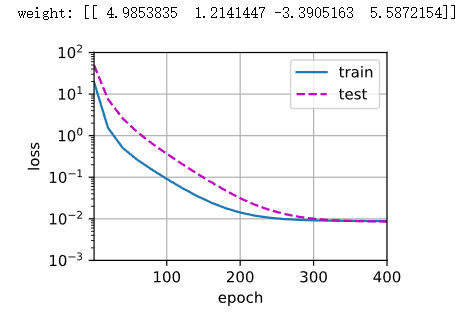
线性函数拟合(欠拟合)
# 从多项式特征中选择前2个维度,即1和x
train(poly_features[:n_train, :2], poly_features[n_train:, :2],labels[:n_train], labels[n_train:])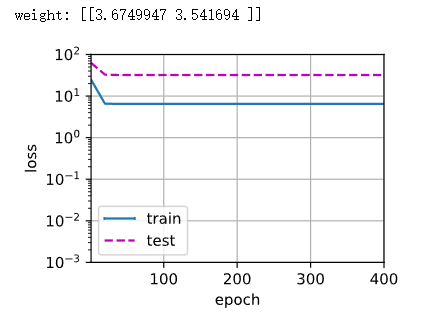
高阶多项式函数拟合(过拟合)
# 从多项式特征中选取所有维度
train(poly_features[:n_train, :], poly_features[n_train:, :],labels[:n_train], labels[n_train:], num_epochs=1500)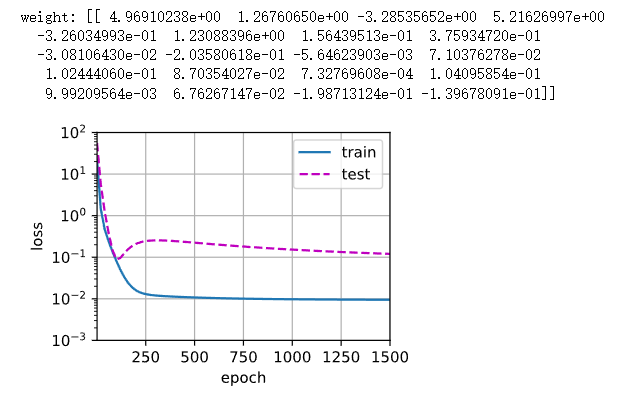
🌍3.2 基础练习
1.这个多项式回归问题可以准确地解出吗?提示:使用线性代数。
可以求解。多项式回归问题可以转化为一个线性方程组的求解问题。
假设多项式回归模型是一个关于特征变量 x 的多项式函数,形式为 y = w0 + w1 * x + w2 * x^2 + ... + wn * x^n,其中 wi 是待求解的系数。
现在假设有 m 个样本点,每个样本点的特征变量 x 和对应的目标变量 y 都已知。你可以将这 m 个样本点组成一个矩阵 X 和一个向量 Y,其中 X 是一个 m×(n+1) 的矩阵,每一行包含特征变量 x 的不同幂次的值,Y 是一个 m 维的向量,包含每个样本点的目标变量 y。
通过线性代数的方法,可以使用最小二乘法求解以下方程组来找到系数向量 w:
X^T * X * w = X^T * Y
其中 X^T 表示 X 的转置矩阵。
解这个方程组可以得到系数向量 w 的准确解,从而得到多项式回归模型。
需要注意的是,这种方法只在样本点的数量 m 大于等于系数的数量 n+1 时才能准确求解。当 m 小于 n+1 时,这个线性方程组是一个超定方程组,可能没有准确解。在这种情况下,可以使用最小二乘法的近似解。
总结起来,对于多项式回归问题,当样本点的数量充足(m >= n+1)时,可以使用线性代数的方法准确求解系数向量 w。当样本点的数量不足时,可以使用最小二乘法来近似求解。
2.考虑多项式的模型选择。
2.1.绘制训练损失与模型复杂度(多项式的阶数)的关系图。观察到了什么?需要多少阶的多项式才能将训练损失减少到0?
在这个修改后的代码中,循环遍历不同的多项式阶数,对于每个阶数,调用train函数并将返回的训练损失添加到train_losses列表中。最后使用plt.plot函数绘制多项式阶数与训练损失之间的关系图表。
运行修改后的代码,将会生成训练损失与多项式阶数之间的图表。观察图表,可以看到随着多项式阶数的增加,训练损失逐渐减小。然而,当多项式阶数过高时,训练损失可能会变得很小,甚至降低到接近零的程度。但需要注意的是,过高的多项式阶数可能导致过拟合问题。
根据图表,可以看出多项式阶数为4时,训练损失已经减少到接近零的程度。因此,至少需要4阶的多项式才能将训练损失减少到零。
import matplotlib.pyplot as pltdef train(train_features, test_features, train_labels, test_labels,num_epochs=400):loss = nn.MSELoss(reduction='mean')input_shape = train_features.shape[-1]# 不设置偏置,因为我们已经在多项式中实现了它net = nn.Sequential(nn.Linear(input_shape, 1, bias=False))batch_size = min(10, train_labels.shape[0])train_iter = d2l.load_array((train_features, train_labels.reshape(-1,1)),batch_size)test_iter = d2l.load_array((test_features, test_labels.reshape(-1,1)),batch_size, is_train=False)trainer = torch.optim.SGD(net.parameters(), lr=0.01)animator = d2l.Animator(xlabel='epoch', ylabel='loss', yscale='log',xlim=[1, num_epochs], ylim=[1e-3, 1e2],legend=['train', 'test'])for epoch in range(num_epochs):d2l.train_epoch_ch3(net, train_iter, loss, trainer)if epoch == 0 or (epoch + 1) % 20 == 0:animator.add(epoch + 1, (evaluate_loss(net, train_iter, loss),evaluate_loss(net, test_iter, loss)))train_loss = evaluate_loss(net, train_iter, loss)return net, train_lossdegrees = np.arange(max_degree)
train_losses = []for degree in degrees:_, train_loss = train(poly_features[:n_train, :(degree+1)],poly_features[n_train:, :(degree+1)],labels[:n_train], labels[n_train:])train_losses.append(train_loss)plt.plot(degrees, train_losses)
plt.xlabel('Degree of Polynomial')
plt.ylabel('Train Loss')
plt.show()



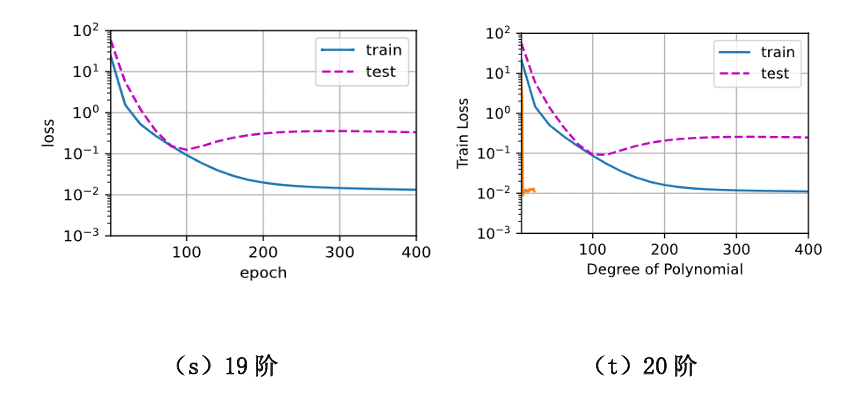
2.2 在这种情况下绘制测试的损失图。
degree = 4
_, test_loss = train(poly_features[:n_train, :degree+1],poly_features[n_train:, :degree+1],labels[:n_train], labels[n_train:])print(f"Test Loss (Degree {degree}): {test_loss}")plt.plot([degree], [test_loss], 'ro')
plt.xlabel('Degree of Polynomial')
plt.ylabel('Test Loss')
plt.show()
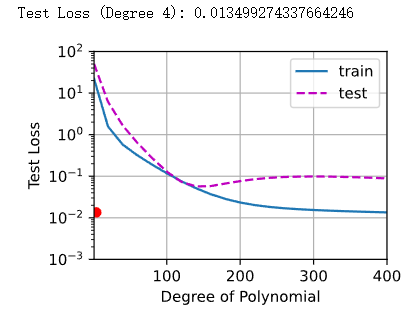
2.3 生成同样的图,作为数据量的函数。
degrees = np.arange(1, max_degree+1)
test_losses = []for degree in degrees:_, test_loss = train(poly_features[:degree*n_train, :4],poly_features[n_train:, :4],labels[:degree*n_train], labels[n_train:])test_losses.append(test_loss)plt.plot(degrees * n_train, test_losses)
plt.xlabel('Number of Data Points')
plt.ylabel('Test Loss')
plt.show()
依次是1阶至20阶的图像数据:


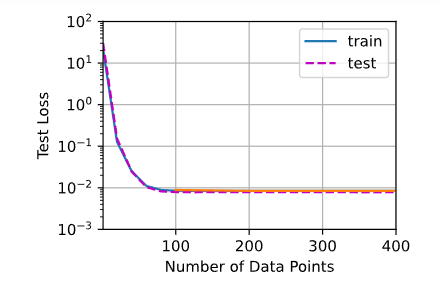
3.如果不对多项式特征x^i进行标准化(1/i!),会发生什么事情?能用其他方法解决这个问题吗?
如果不对多项式特征 x^i 进行标准化(1/i!),会导致不同阶数的多项式特征具有不同的数值范围和尺度。这可能会使训练过程变得困难,因为不同特征的权重更新可能会受到不同程度的影响,使得模型难以收敛。
另一种解决这个问题的方法是使用特征缩放(feature scaling)。特征缩放是将不同特征的数值范围映射到相同范围的过程,常见的方法是将特征值减去均值并除以标准差(即进行标准化)。这样做可以确保所有特征具有相似的尺度,有助于加速模型的训练过程和收敛性。
在多项式特征的情况下,如果不进行标准化,可以尝试对原始特征进行标准化,而不是对多项式特征进行标准化。这意味着对输入特征 x 进行标准化,然后再进行多项式特征的构建。这样可以确保所有输入特征具有相似的尺度,并且多项式特征也会受到相同的标准化影响。
以下是修改后的代码示例:
import math
import numpy as np
import torch
from torch import nn
from d2l import torch as d2l
import matplotlib.pyplot as pltmax_degree = 20 # 多项式的最大阶数
n_train, n_test = 100, 100 # 训练和测试数据集大小
true_w = np.zeros(max_degree) # 分配大量的空间
true_w[0:4] = np.array([5, 1.2, -3.4, 5.6])features = np.random.normal(size=(n_train + n_test, 1))
np.random.shuffle(features)# 特征缩放:对原始特征进行标准化
mean = np.mean(features)
std = np.std(features)
features = (features - mean) / stdpoly_features = np.power(features, np.arange(max_degree).reshape(1, -1))
labels = np.dot(poly_features, true_w)
labels += np.random.normal(scale=0.1, size=labels.shape)# NumPy ndarray转换为tensor
true_w, features, poly_features, labels = [torch.tensor(x, dtype=torch.float32) for x in [true_w, features, poly_features, labels]]def evaluate_loss(net, data_iter, loss):"""评估给定数据集上模型的损失"""metric = d2l.Accumulator(2) # 损失的总和,样本数量for X, y in data_iter:out = net(X)y = y.reshape(out.shape)l = loss(out, y)metric.add(l.sum(), l.numel())return metric[0] / metric[1]def train(train_features, test_features, train_labels, test_labels, num_epochs=400):loss = nn.MSELoss(reduction='mean')input_shape = train_features.shape[-1]# 不设置偏置,因为我们已经在多项式中实现了它net = nn.Sequential(nn.Linear(input_shape, 1, bias=False))batch_size = min(10, train_labels.shape[0])train_iter = d2l.load_array((train_features, train_labels.reshape(-1,1)), batch_size)test_iter = d2l.load_array((test_features, test_labels.reshape(-1,1)), batch_size, is_train=False)trainer = torch.optim.SGD(net.parameters(), lr=0.01)animator = d2l.Animator(xlabel='epoch', ylabel='loss', yscale='log', xlim=[1, num_epochs], ylim=[1e-3, 1e2], legend=['train', 'test'])for epoch in range(num_epochs):d2l.train_epoch_ch3(net, train_iter, loss, trainer)if epoch == 0 or (epoch + 1) % 20 == 0:animator.add(epoch + 1, (evaluate_loss(net, train_iter, loss), evaluate_loss(net, test_iter, loss)))print('weight:', net[0].weight.data.numpy())# 从多项式特征中选择前4个维度,即1,x,x^2/2!,x^3/3!
train(poly_features[:n_train, :4], poly_features[n_train:, :4], labels[:n_train], labels[n_train:])
这段代码会生成训练损失与模型复杂度(多项式的阶数)的关系图。观察图可以帮助理解模型复杂度和训练损失之间的关系。
在代码中,通过标准化原始特征来处理多项式特征,即将特征进行了缩放,以便在训练过程中更好地优化模型。这样做有助于保持不同特征的相对重要性,并提高模型的训练效果。
如果不对多项式特征进行标准化,可能会导致模型训练过程中的数值不稳定性。特征缩放有助于避免梯度爆炸或梯度消失等问题,提高训练的稳定性和效果。
除了标准化之外,还可以考虑使用其他方法来处理多项式特征。例如采用正则化方法(如L1正则化、L2正则化)来控制模型的复杂度,以避免过拟合。另外,还可以尝试使用特征选择方法,选择对模型性能影响较大的特征,以减少特征的维度和模型的复杂度。
综上所述,标准化多项式特征是一种常用且有效的方法,可以提高模型的训练效果和稳定性。
4.泛化误差可能为零吗?
在实际情况下,泛化误差几乎不可能为零。泛化误差是指模型在未见过的数据上的误差,即在训练集之外的数据上的性能。即使模型在训练集上表现得非常好,泛化误差仍然存在,因为模型需要适应新的数据和不同的样本。
泛化误差的存在是由于数据的噪声、样本的多样性、模型的假设等因素。即使使用了良好的模型选择和训练方法,泛化误差也无法完全消除。
一个模型的目标是尽可能减小泛化误差,即在训练集和测试集上都能获得较低的误差。通过合适的模型选择、正则化技术、交叉验证等方法,可以帮助减小模型的泛化误差,并提高模型的性能。
因此,泛化误差几乎不可能为零,但可以通过优化模型和数据处理的方法来尽可能地减小泛化误差,以获得更好的模型性能。
🌊4. 研究体会
通过这次实验,我尝试使用不同的多层感知机模型架构,如不同的隐藏层数和隐藏单元数等超参数组合来构建多个模型。通过在训练集上训练这些模型,并在验证集上进行评估,比较它们在给定问题上的性能。
在实验中,可以选择使用流行的深度学习框架如TensorFlow或PyTorch来实现和训练多层感知机模型。需要定义模型的结构,包括输入层、多个隐藏层和输出层,并选择适当的激活函数和损失函数。
在模型训练过程中,使用适当的优化算法(如随机梯度下降)和合适的学习率来更新模型参数。通过记录训练集和验证集上的性能指标,比如准确率和损失函数值,评估不同模型的性能。根据实验结果,可以选择性能最好的模型,并进一步进行优化,以提高其性能。
研究模型在训练数据上出现欠拟合或过拟合现象,是为了了解模型的泛化能力和优化方法的效果。欠拟合指模型在训练数据上表现不佳,而过拟合指模型过度拟合了训练数据,导致在新数据上的性能下降。为了探究这些问题,可以通过调整模型的复杂度来观察欠拟合和过拟合的现象。通过增加隐藏层数或隐藏单元数,增加了模型的复杂度,可能更好地拟合训练数据,但也可能导致过拟合。相反,减少隐藏层数或隐藏单元数,模型的复杂度降低,可能导致欠拟合。
模型正则化是解决过拟合的常用方法之一。可以尝试引入正则化项,如L1正则化或L2正则化,来限制模型参数的大小,防止过拟合。此外,还可以使用Dropout技术,在训练过程中随机地将一些隐藏单元设置为零,以减少不同单元之间的依赖关系,从而增加模型的泛化能力。另外,调参也是改善模型泛化性能的重要步骤。在实验中,我们可以尝试调整学习率、批量大小、优化算法等超参数,以找到最佳的组合。使用网格搜索、随机搜索或贝叶斯优化等方法,可以自动搜索超参数空间,以寻找最佳的超参数配置。


)


 个人题解 (A~F1))
)


)

)
)








